Overnight, Refrigerator Focaccia = The Best Focaccia Bread Recipe
This post may contain affiliate links. Please read my disclosure policy.
Cold, refrigerated dough is the secret to making delicious focaccia! Allowing the dough to rest 18 to 48 hours in the fridge will yield extra-pillowy and airy focaccia, though if you are pressed for time, you can make this start-to-finish in 3 hours. This 4-ingredient recipe requires only 5 minutes of hands-on time. Video guidance below!
⭐️⭐️⭐️⭐️⭐️ Review:
“Love this recipe! I’ve made this so many times that I’ve lost count. Super simple and delicious. My family loves it. Whenever someone asks me for a focaccia recipe, I always show them this one. This recipe is awesome. Thank you for sharing!” — Lucy
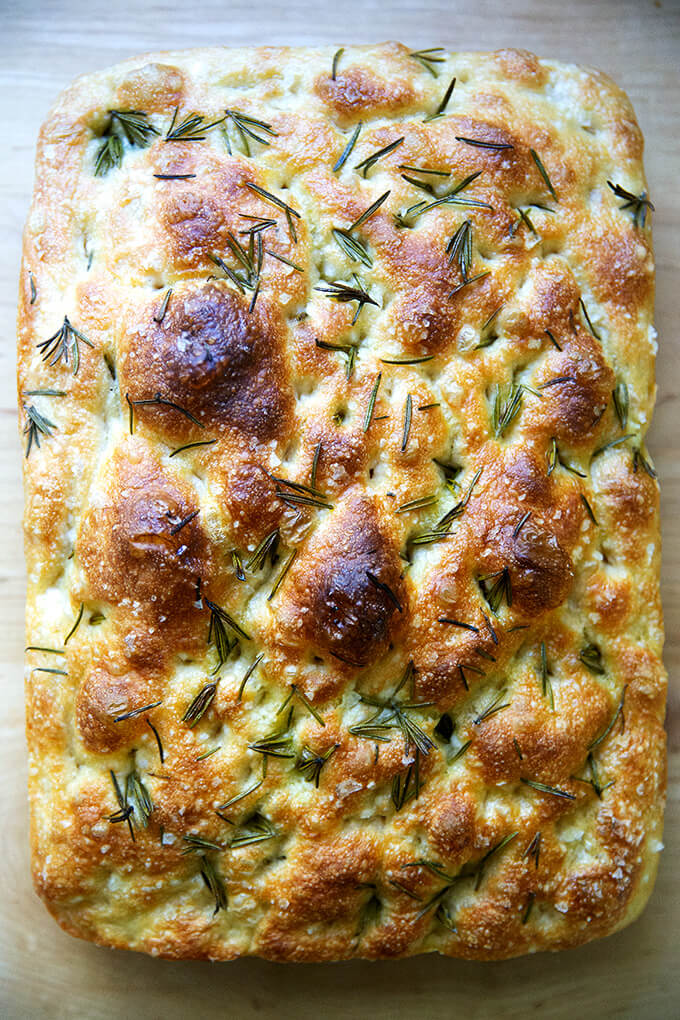
I’ve said it before and I’ll say it again: focaccia is the bread recipe for beginners. Why? Because:
- The no-knead, 4-ingredient dough takes 5 minutes to mix together.
- It requires no special equipment, no tricky shaping technique, and no scoring.
- If you have a 9×13-inch baking pan and your fingertips (for dimpling), you’re good to go.
- It emerges soft and pillowy, olive oil-crusted, golden all around, and it’s completely irresistible.
In sum, it’s hard to beat focaccia (pronounced foh-kah-chuh) in the effort-to-reward category. If you are intimidated by bread baking, this is the recipe I suggest making first, both for its simplicity and flavor. After all, this focaccia bread recipe is adapted from my mother’s simple peasant bread recipe, a recipe that has removed the fear of the bread baking process for many.
For the past few months, I’ve been making the focaccia bread recipe from my cookbook Bread Toast Crumbs, but changing the method: using more yeast, using less yeast, doing longer, slower rises at room temperature, doing longer, slower rises in the refrigerator. Find the results below.
This post is organized as follows:
- What Makes The Best Focaccia
- Four Tips for Success
- How This Focaccia Recipe Differs from Others
- Focaccia Bread Ingredients
- How to Make Focaccia, Step by Step
- Adding Rosemary, Herbs and Other Toppings to your Focaccia Dough
- How to Make a Focaccia Bread Art
- Tomato Focaccia
- How to Make a Focaccia Bread Sandwich
- Can I Skip the Overnight Rise?
PS: Once you master this simple focaccia, try your hand at this simple sourdough bread recipe, another recipe that requires minimal effort but yields spectacular results.
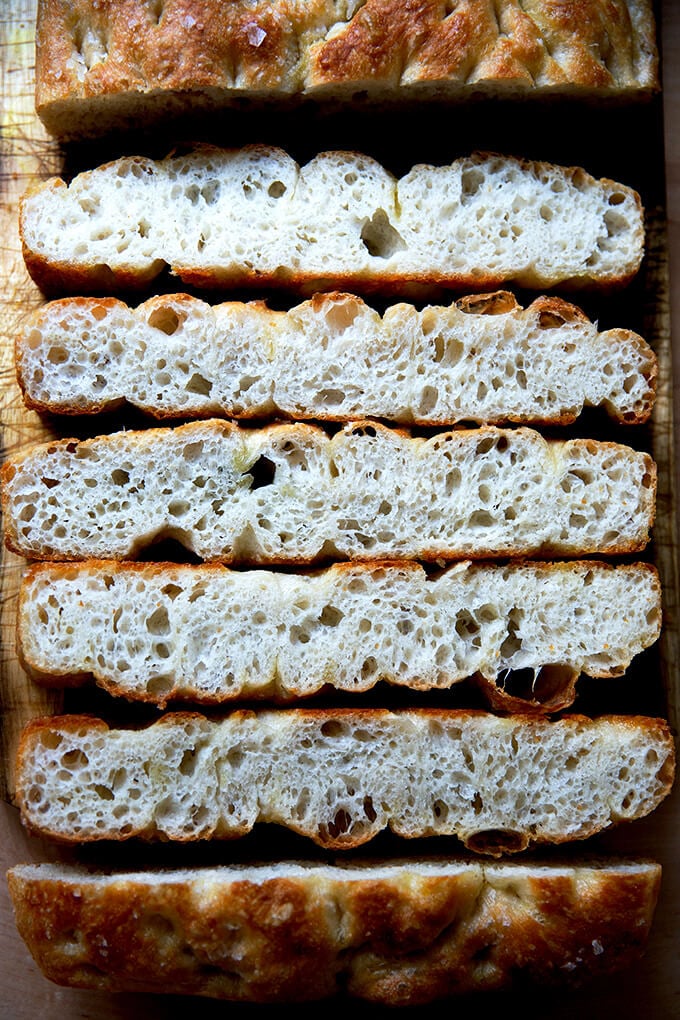
What Makes The Best Focaccia?
I’ll spare you all the details of the various experiments and skip straight to what I’ve found creates the best focaccia, one that emerges golden all around, looking like a brain, its surface woven with a winding labyrinth of deep crevices: high-hydration, refrigerated dough.
This is nothing novel—many bakers extol the virtues of the cold fermentation process—and it came as no surprise to me either: it was, after all, past-prime Jim Lahey refrigerated dough that showed me how easy focaccia could be: place cold, several-days-old pizza dough in a well-oiled pan, let it rise for several hours or until it doubles, drizzle with more oil, dimple with your fingers, sprinkle with sea salt, then bake until done.
Employing a refrigerator rise requires more time because the cold environment slows everything down initially, and during the second rise, the cold dough takes time to warm to room temperature. The overall effort, however, is very hands-off, and the result — a light, airy, pillowy dough — is well worth it.
As important as refrigerating the dough is using a high hydration dough, meaning a dough with a high proportion of water relative to the flour. The high proportion of water will create a dough with beautiful air pockets throughout. (Incidentally, this is the secret to making excellent pizza dough as well as light, airy sourdough sandwich bread.)
How This Focaccia Recipe Differs from Others
There are lots of focaccia bread recipes out there, so why make this one? This one differs from many of the recipes out there in two ways:
- The long, cold, refrigerator rise.
- The absence of sugar or honey or any sort of sweetener.
Why isn’t there any sweetener in this recipe? Simply stated, a sweetener is just not needed — the yeast, contrary to popular belief, does not need sugar to activate or thrive. Sugar will speed things up, but when you’re employing a long, slow rise, speed is not the name of the game.
Moreover, and this is getting a little scientific, but during the long, cold fermentation: enzymes in both the flour and the yeast will break down the starches in the flour into simple sugars, which will contribute both to flavor and to browning, again rendering sugar unnecessary. Cool, right?
Four Tips for Success
- Allowing the dough to rest 18 to 24 hours in the fridge yields the best results. (You can leave the dough in the fridge for as long as 72 hours.)
- A buttered or parchment-lined pan in addition to the olive oil will prevent sticking. When I use Pyrex or other glass pans, butter plus oil is essential to prevent sticking. When I use my 9×13-inch USA Pan, I can get away with using olive oil alone.
- Count on 2 to 4 hours for the second rise. This will depend on the temperature of your kitchen and the time of year.
- After the second rise, dimple the dough, then immediately stick the pans in the oven — this has been a critical difference for me in terms of keeping those desirable crevices. If you dimple and let the dough rise again even for 20 minutes before popping the pan in the oven, the crevices begin to dissolve.
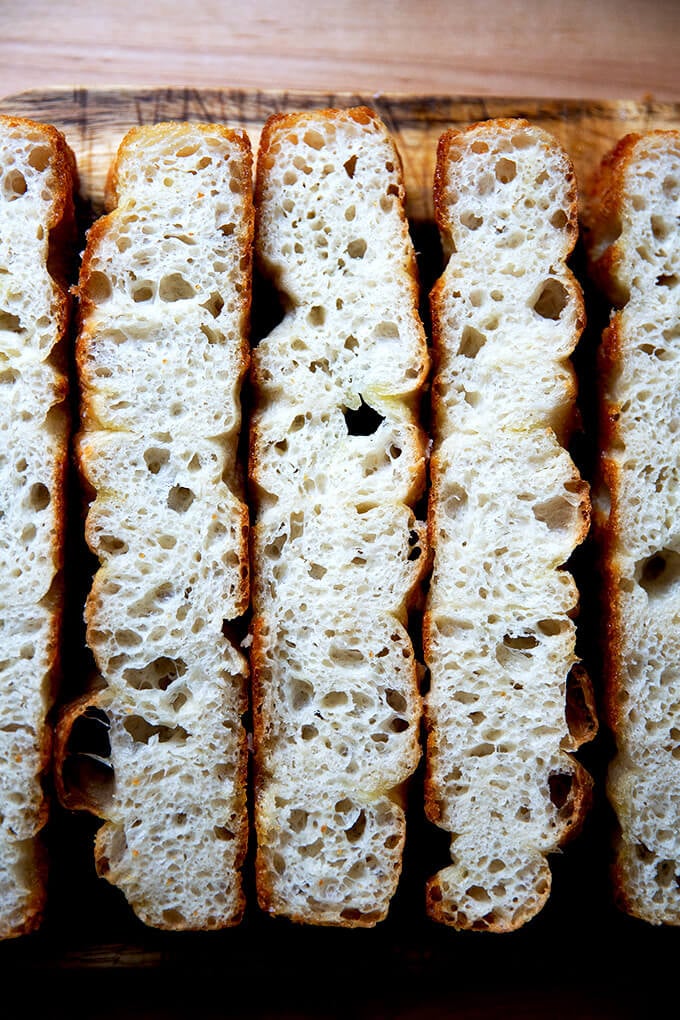
Ingredients
- Flour: bread flour or all-purpose flour will work equally well here. If you live in a humid environment or abroad, I suggest trying to get your hands on bread flour. King Arthur Flour is my preference.
- Yeast: SAF Instant Yeast is my preference, but active dry yeast works just as well. See recipe box for instructions on how to use active-dry yeast in place of instant.
- Salt: I say this all the time, but a big part of making a good loaf of bread comes down simply to using the right amount of salt given the amount of flour you are using by weight. It’s like anything: bread has to be well seasoned. At a minimum, use 10 grams (2 teaspoons) of salt for every 500 grams (4 cups) of flour. I highly recommend investing in some good, flaky sea salt for sprinkling on top of the focaccia dough — it tastes better than the more finely ground varieties of salt. I use Diamond Crystal kosher salt for the dough, but any salt you have on hand will work just fine for the dough.
- Water: There is a lot of water in this dough — it’s 88% hydration — and all of that water helps produce a light, airy, pillowy dough.
- Olive oil: Olive oil both in the bottom of the pan and on top of the dough is essential for encouraging nice browning, flavor, and that quintessential oiliness we all love about focaccia.
- Rosemary or other seasonings: Rosemary is a classic focaccia topping, and you can either sprinkle it over the dough before baking or you can chop it up and add it to the dough. Many people love sun-dried tomatoes and olives in their focaccia. See below for how to incorporate these other ingredients into your focaccia dough.
How to Make Focaccia Bread, Step by Step
Gather your ingredients: 4 cups (512 g) flour, 2 teaspoons (10 g) salt, 2 teaspoons (8 g) instant yeast (SAF is my preference), 2 cups (455 g) water:
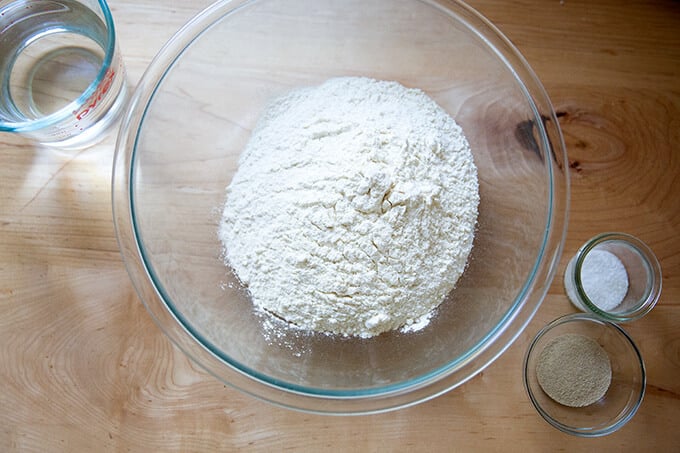
Whisk together the flour, salt, and yeast first:
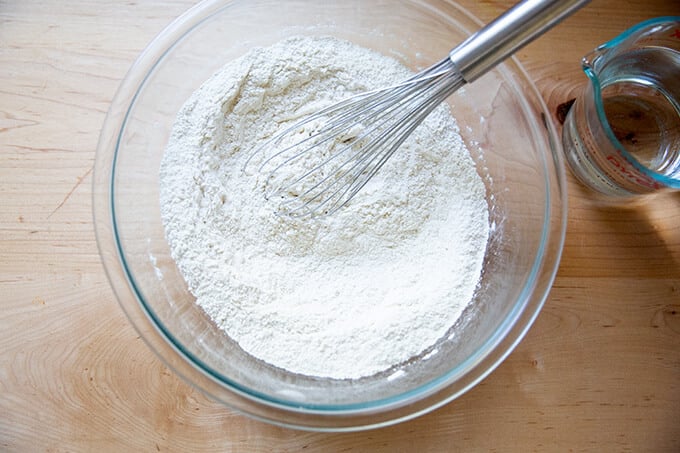
Add the water:
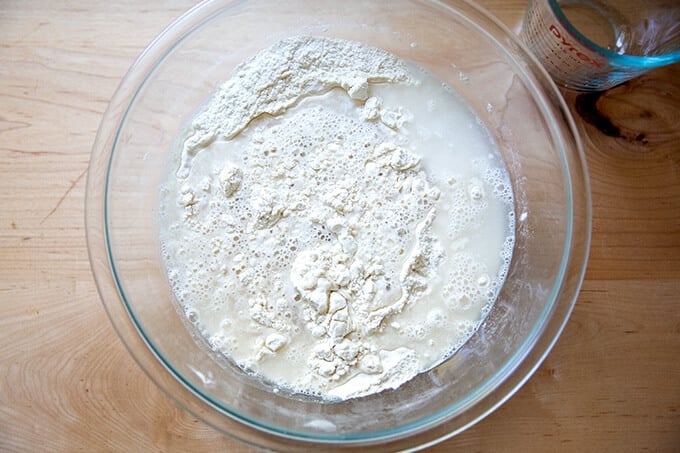
Use a spatula to stir the two together.
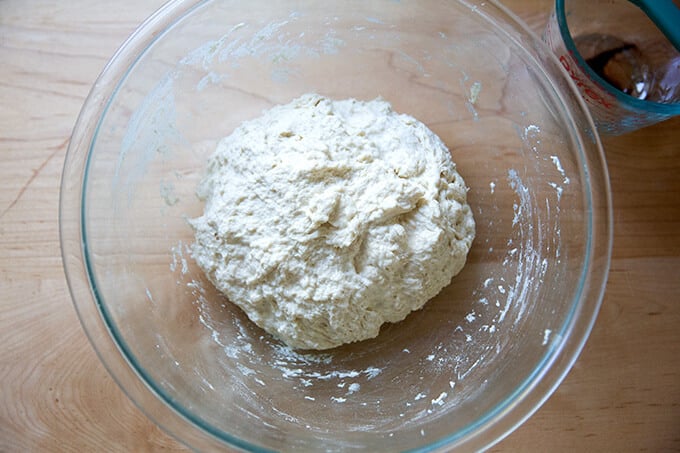
Slick the dough with olive oil:
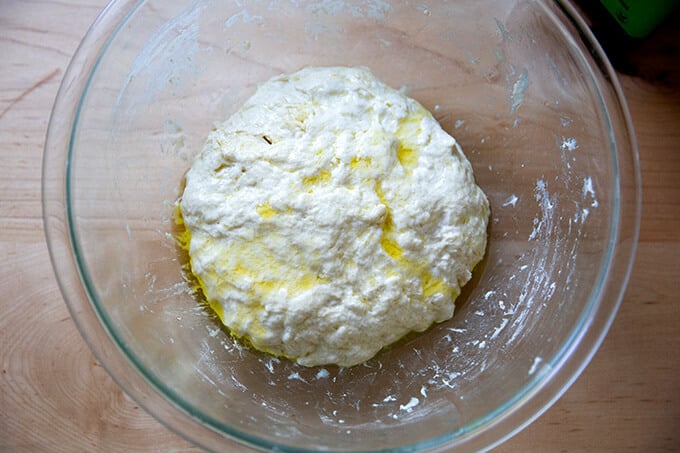
Slick the surface of the dough with olive oil; then cover the bowl. You all have one of these, right? Stick the bowl in the fridge immediately; leave it there to rise for 12 to 18 hours (or longer—I’ve left it there for as long as three days). NOTE: It is important the dough really be slicked with olive oil especially if you are using a cloth bowl cover or tea towel as opposed to plastic wrap or the lid pictured in the photo below this one. If you are using a tea towel, consider securing it with a rubber band to make a more airtight cover. If you do not slick the dough with enough oil, you risk the dough drying out and forming a crust over the top layer.
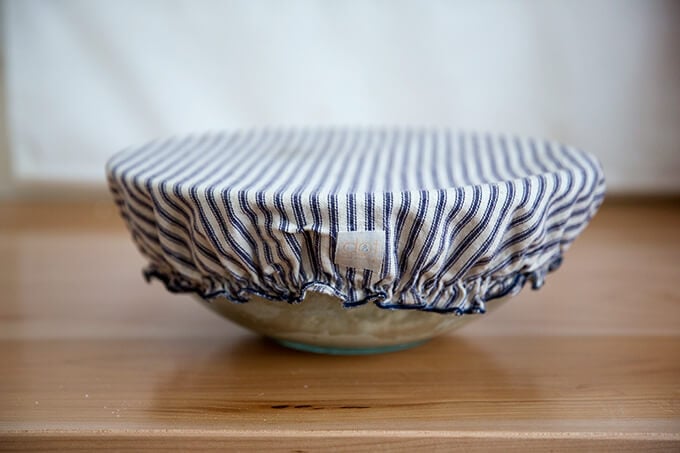
Another option: the lid that comes with the 4-Qt Pyrex bowl. This is handy for fridge storage because you can stack things on top of it.
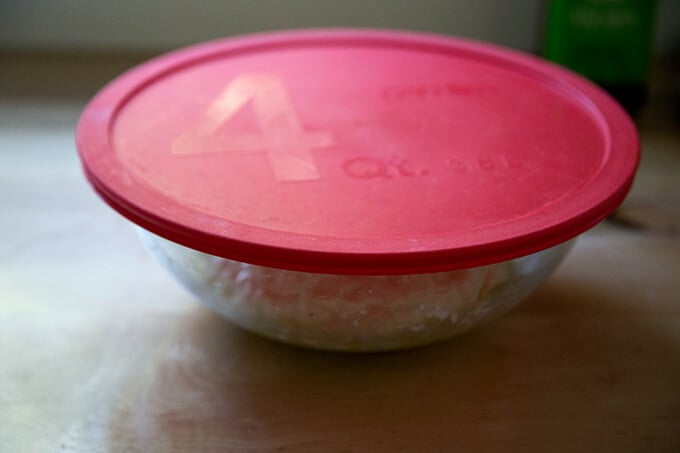
Remove from fridge, and remove the cover:
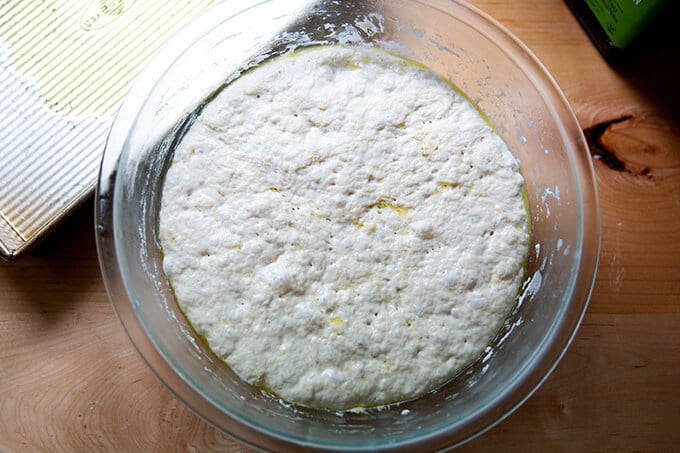
Deflate the dough and transfer to a prepared pan. I love this 9×13-inch USA pan. If you don’t have one you can use two 8- or 9-inch pie plates or something similar. If you are using glass baking dishes be sure to grease the dishes with butter before pouring a tablespoon of olive oil into each. (The butter will ensure the bread doesn’t stick.) Don’t touch the dough again for 2 to 4 hours depending on your environment.
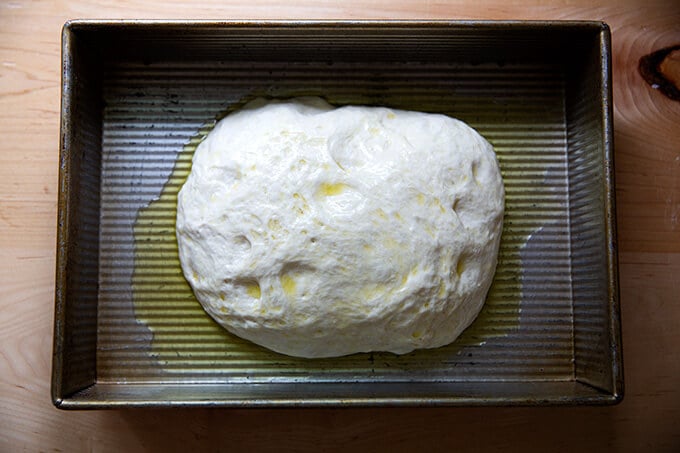
After two to four hours, or when the dough looks like this…:
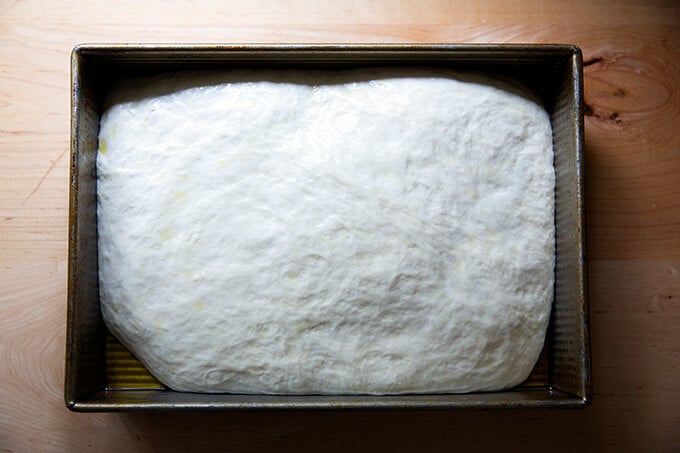
… it’s time to dimple it! You can use simply olive oil and salt — I recommend good, flaky sea salt for this. Note, the dough in the photo below spent three days in the fridge, and the dough was super bubbly!
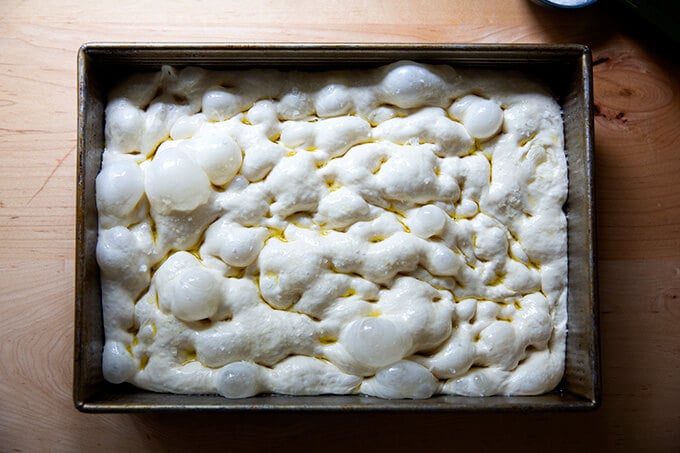
if you are using rosemary, sprinkle it over the dough. Then pour two tablespoons of olive oil over the dough, and using your fingers, press straight down to create deep dimples. Sprinkle with flaky sea salt — again, something like Maldon is great here.

Transfer to oven immediately and bake at 425ºF for 25 minutes or until golden all around. Remove focaccia from pans and place on cooling racks.
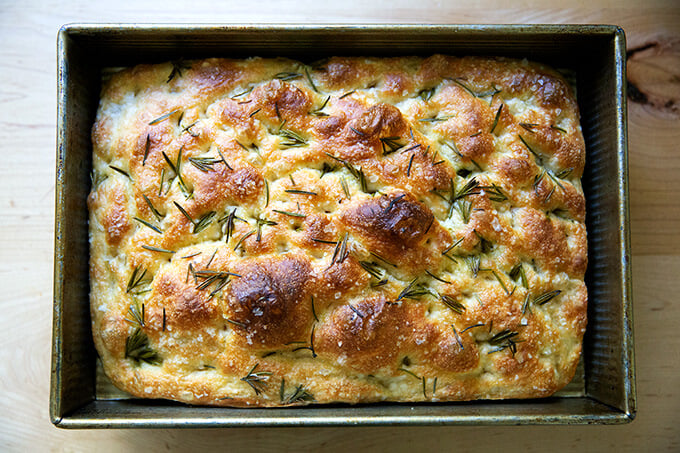

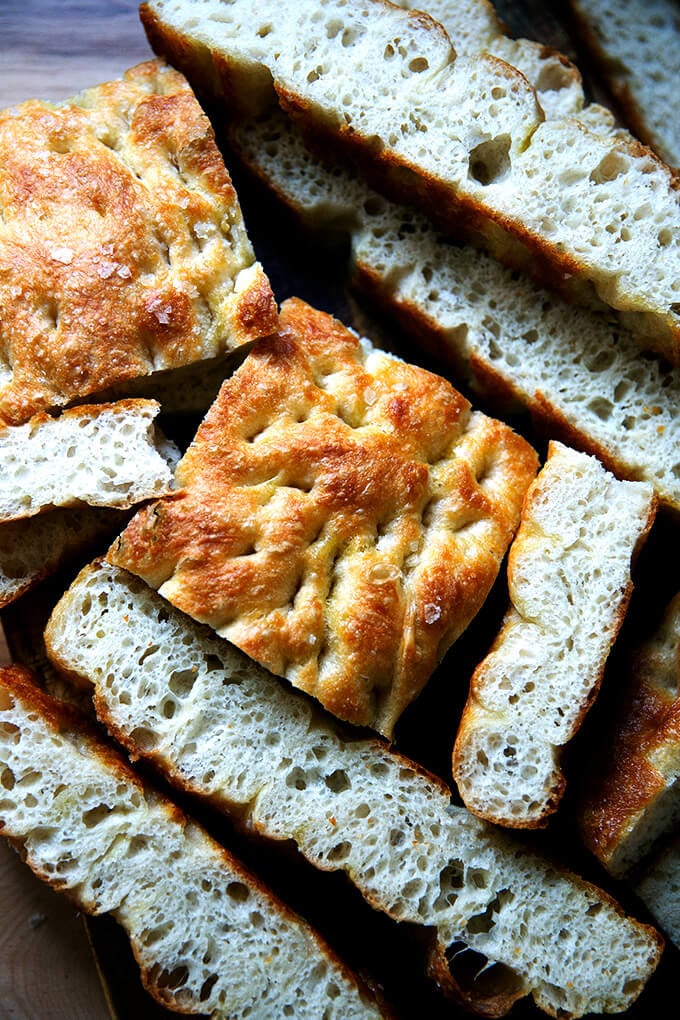
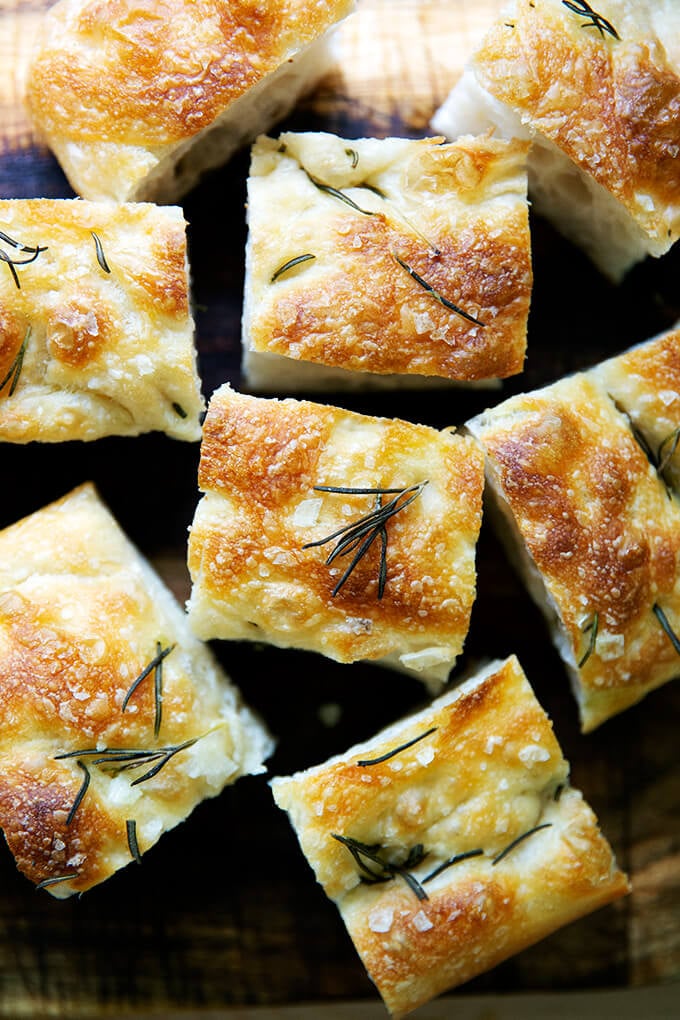
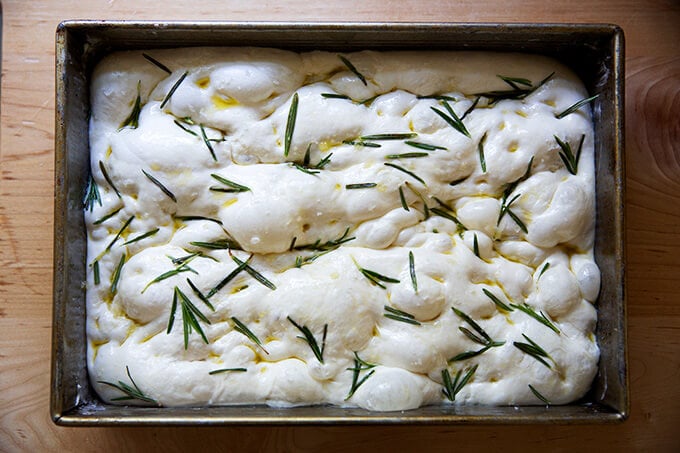
How to Incorporate Rosemary, Herbs, and Other Ingredients & Toppings into Your Focaccia Dough
One of the most frequently asked questions I get is: How can I add other toppings or ingredients to my focaccia bread? You can do this in two ways:
- Add them on top as you would rosemary or other herbs. The key is to make sure the ingredients are slicked lightly with olive oil to ensure they do not burn in the oven. I like to sprinkle the rosemary over top of the dough, then drizzle it with olive oil, then dimple the dough.
- You can add them directly to the dough. In step one, when you whisk together the flour, salt, and instant yeast, add your ingredients — chopped olives, sun-dried tomatoes, roasted garlic — to the flour and toss to coat; then add the water.
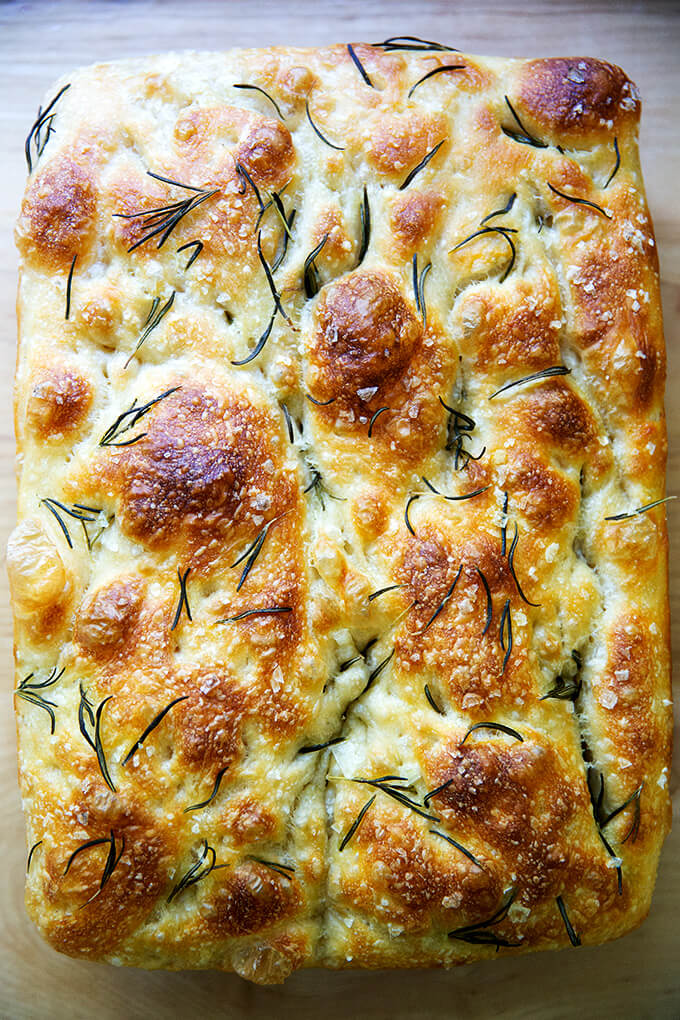
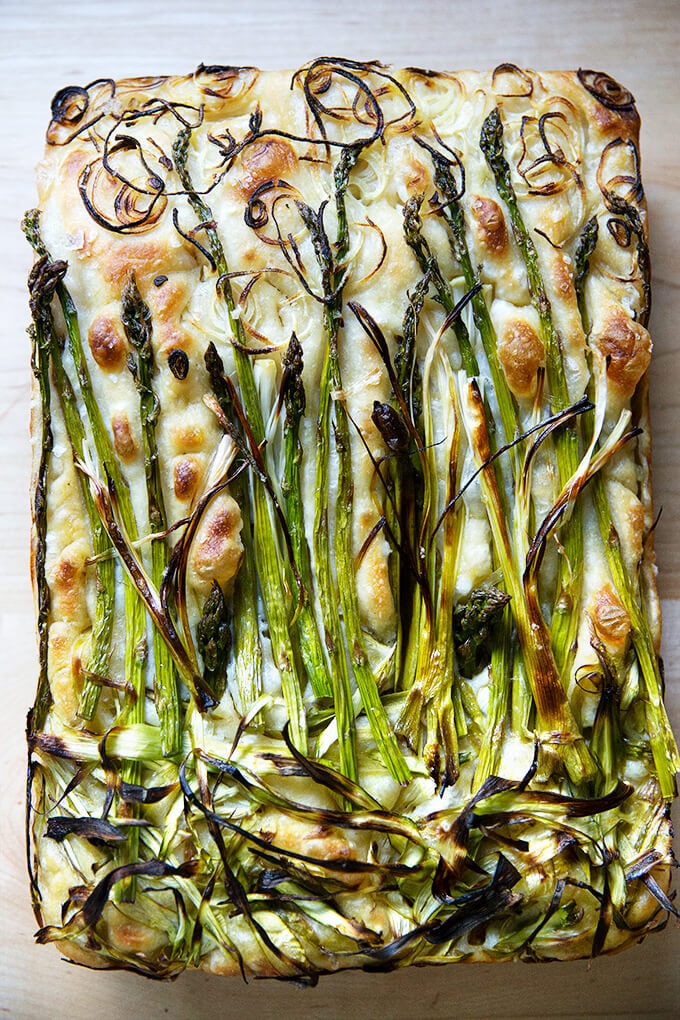
How to Make a Focaccia Bread Art
Pictured above is my “Ode to Spring” (🤣) Focaccia Bread Art (or Garden Scape). As noted above, the key with adding toppings is to slick them lightly with olive oil to ensure they don’t completely char. Keep in mind that some items will char, and a little charring is not a bad thing.
To make a focaccia bread art:
- Follow the recipe through the step in which you dimple the dough just before baking. Arrange your toppings — sliced peppers, asparagus, scallions, olives, tomatoes, onions, etc. — over top and dimple again, pressing the ingredients into the dough to embed them — you can be more aggressive than you think.
- Brush the entire surface with olive oil; then sprinkle with sea salt.
- Bake as directed.
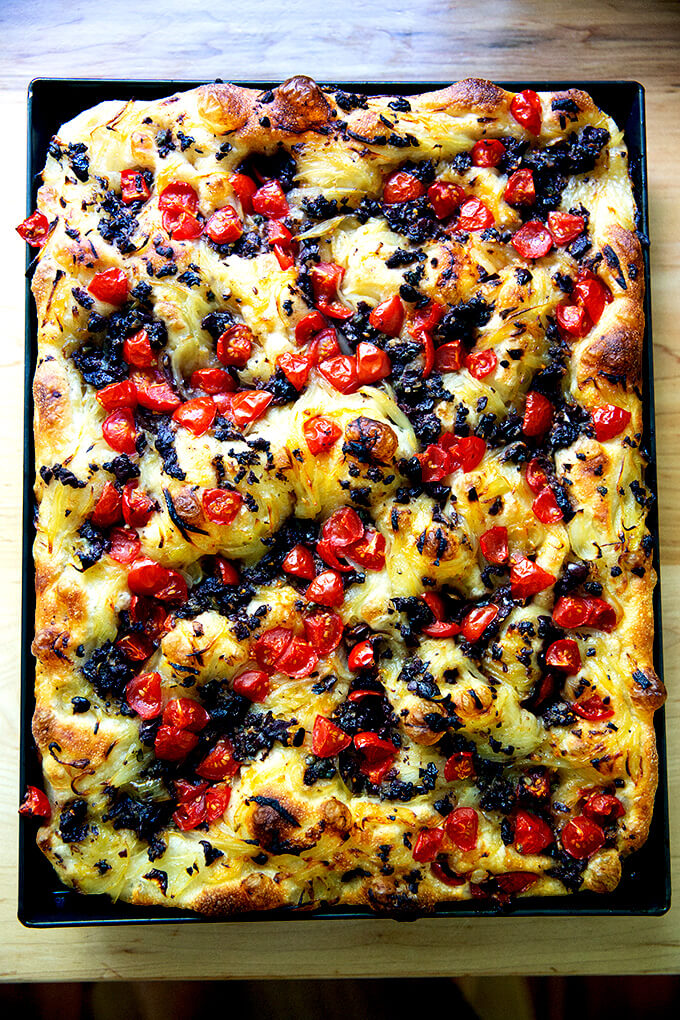
Tomato Focaccia
Pictured above is a cross between pissaladière and tomato focaccia. I love the addition of tomatoes to pissaladière because it adds a freshness and brightness, a hit of acidity to offset the sweet caramelized onions and salty anchovies, olives, and capers.
You can use any summer tomatoes you have on hand — diced cherry tomatoes, Roma, plum, sliced beefsteak tomatoes, heirloom tomatoes, etc. If you choose to dice up Roma or plum tomatoes, there is no need to seed them, but leave any juices lingering on the cutting board behind.
Top the unbaked focaccia with a thin layer of tomatoes; then bake as directed.
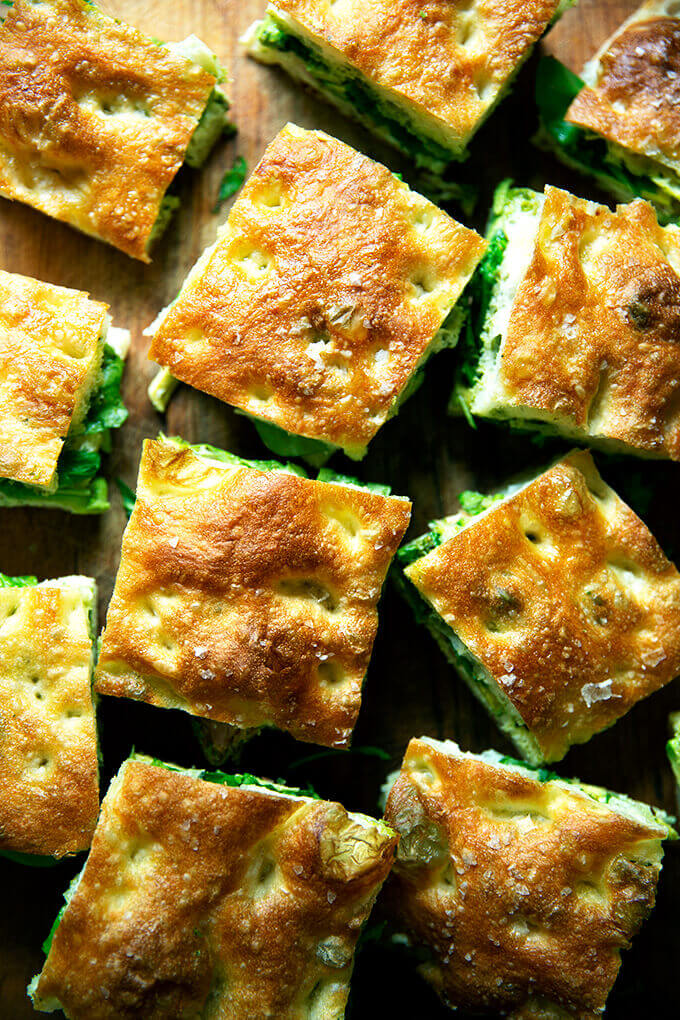
How to Make Focaccia Bread Sandwiches
One of my favorite things to do with either the rounds of focaccia or the 9×13-inch slab of focaccia is to make a giant sandwich: simply halve the whole finished loaf of focaccia in half crosswise; fill it as you wish, close the sandwich; then slice and serve.
Here’s one of my favorites: Roasted Red Peppers, Olive Tapenade, & Whipped Honey Goat Cheese
Can I Make this Overnight Focaccia Without the Overnight Rise?
Yes, you can. In fact, in my cookbook, Bread Toast Crumbs, I do not employ an overnight rise. Start-to-finish it can be made in about three hours. The finished bread will not be as pillowy, but it will still be light, airy, and delicious.
To skip the overnight rise, simply let the mixed dough rise at room temperature until doubled, about 1.5 to 2 hours. Then proceed with the recipe, knowing the second rise will only take about 30 minutes.
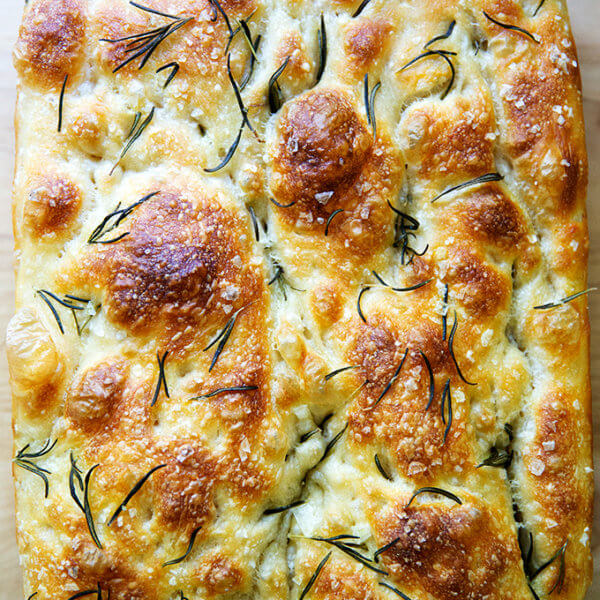
The Best, Easiest Focaccia Bread Recipe
- Total Time: 18 hours 30 minutes
- Yield: 2 loaves
Description
Cold, refrigerated dough is the secret to making delicious focaccia! Allowing the dough to rest 18 to 24 hours in the fridge will yield extra-pillowy and airy focaccia, though if you are pressed for time, you can make this start-to-finish in 3 hours. This 4-ingredient recipe requires only 5 minutes of hands-on time. Video guidance below!
Adapted from the focaccia recipe in Bread Toast Crumbs.
A few notes:
- Plan ahead: While you certainly could make this more quickly, it turns out especially well if you mix the dough the day before you plan on baking it. The second rise, too, takes 2 to 4 hours.
- If you are short on time and need to make the focaccia tonight: Let the mixed dough rise at room temperature until doubled, about 1.5 to 2 hours. Then proceed with the recipe, knowing the second rise will only take about 30 minutes.
- You can use various pans to make this focaccia such as: two 9-inch Pyrex pie plates. (Use butter + oil to prevent sticking.) One 9×13-inch pan, such as this USA pan — do not split the dough in half, if you use this option, which will create a thicker focaccia . A 13×18-inch rimmed sheet pan — this creates a thinner focaccia, which is great for slab sandwiches.
- As always, for best results, use a digital scale to measure the flour and water.
- I love SAF instant yeast. I buy it in bulk, transfer it to a quart storage container, and store it in my fridge for months. You can store it in the freezer also.
- If you are using active-dry yeast, simply sprinkle the yeast over the lukewarm water and let it stand for 15 minutes or until it gets foamy; then proceed with the recipe.
- Flour: You can use all-purpose or bread flour here with great results. If you live in a humid environment, I would suggest using bread flour. If you are in Canada or the UK, also consider using bread flour or consider holding back some of the water. Reference the video for how the texture of the bread should look; then add water back as needed.
Ingredients
- 4 cups (512 g) all-purpose flour or bread flour, see notes above
- 2 teaspoons (10 g) kosher salt
- 2 teaspoons (8 g) instant yeast, see notes above if using active dry
- 2 cups (455 g) lukewarm water, made by combining 1/2 cup boiling water with 1 1/2 cups cold water
- butter for greasing
- 4 tablespoons olive oil, divided
- flaky sea salt, such as Maldon
- 1 to 2 teaspoons whole rosemary leaves, optional
Instructions
- Make the dough: In a large bowl, whisk together the flour, salt, and instant yeast. Add the water. Using a rubber spatula, mix until the liquid is absorbed and the ingredients form a sticky dough ball. Rub the surface of the dough lightly with olive oil. Cover the bowl with a damp tea towel, cloth bowl cover, or plastic wrap and place in the refrigerator immediately for at least 12 hours or for as long as three days. (See notes above if you need to skip the overnight rise for time purposes.) NOTE: It is important the dough really be slicked with olive oil especially if you are using a cloth bowl cover or tea towel as opposed to plastic wrap or a hard lid. If you are using a tea towel, consider securing it with a rubber band to make a more airtight cover. If you do not slick the dough with enough oil, you risk the dough drying out and forming a crust over the top layer.
- Line two 8- or 9-inch pie plates or a 9×13-inch pan (see notes above) with parchment paper or grease with butter or coat with nonstick cooking spray. (Note: This greasing step may seem excessive, but with some pans, it is imperative to do so to prevent sticking. With my USA pans, I can get away with olive oil alone; with my glass baking dishes, butter is a must.)
- Pour a tablespoon of oil into the center of each pan or 2 tablespoons of oil if using the 9×13-inch pan. Using two forks, deflate the dough by releasing it from the sides of the bowl and pulling it toward the center. Rotate the bowl in quarter turns as you deflate, turning the mass into a rough ball. Use the forks to split the dough into two equal pieces (or do not split if using the 9×13-inch pan). Place one piece into one of the prepared pans. Roll the dough ball in the oil to coat it all over, forming a rough ball. Repeat with the remaining piece. Let the dough balls rest for 3 to 4 hours depending on the temperature of your kitchen (Note: no need to cover for this room temperature rise).
- Set a rack in the middle of the oven and preheat it to 425°F. If using the rosemary, sprinkle it over the dough. Pour a tablespoon of oil over each round of dough (or two tablespoons if using a 9×13-inch pan). Rub your hands lightly in the oil to coat, then, using all of your fingers, press straight down to create deep dimples. If necessary, gently stretch the dough as you dimple to allow the dough to fill the pan. Sprinkle with flaky sea salt all over.
- Transfer the pans or pan to the oven and bake for 25 to 30 minutes, until the underside is golden and crisp. Remove the pans or pan from the oven and transfer the focaccia to a cooling rack. Let it cool for 10 minutes before cutting and serving; let it cool completely if you are halving it with the intention of making a sandwich.
- Prep Time: 18 hours
- Cook Time: 30 minutes
- Category: Bread
- Method: Oven
- Cuisine: Italian
This post may contain affiliate links. Please read my disclosure policy.

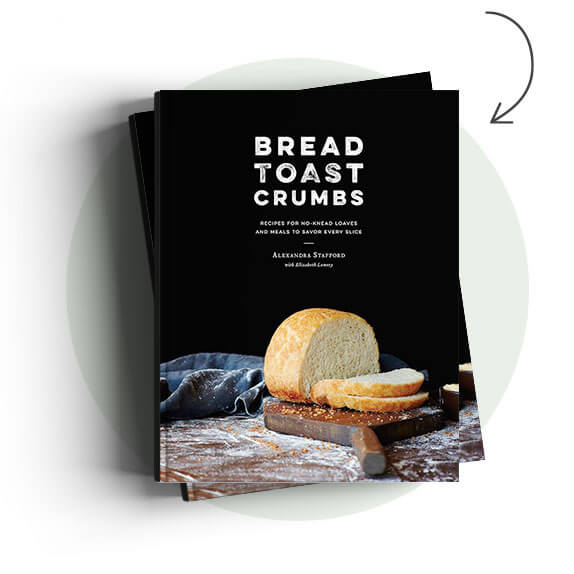

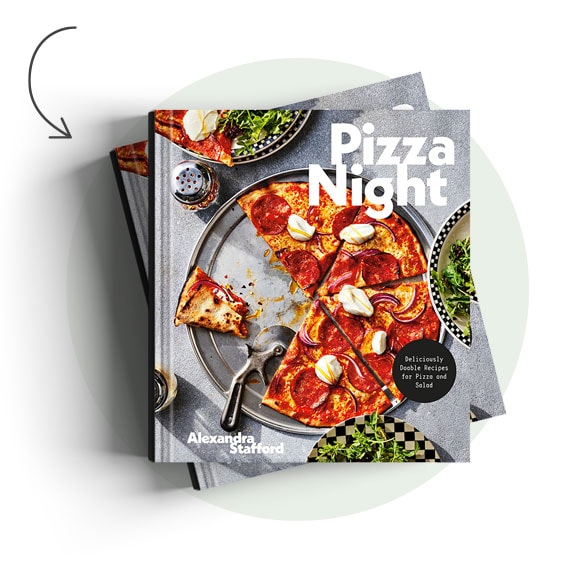


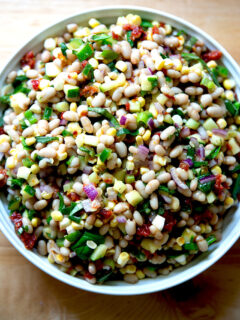
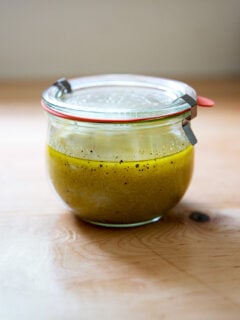
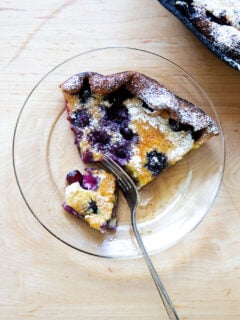

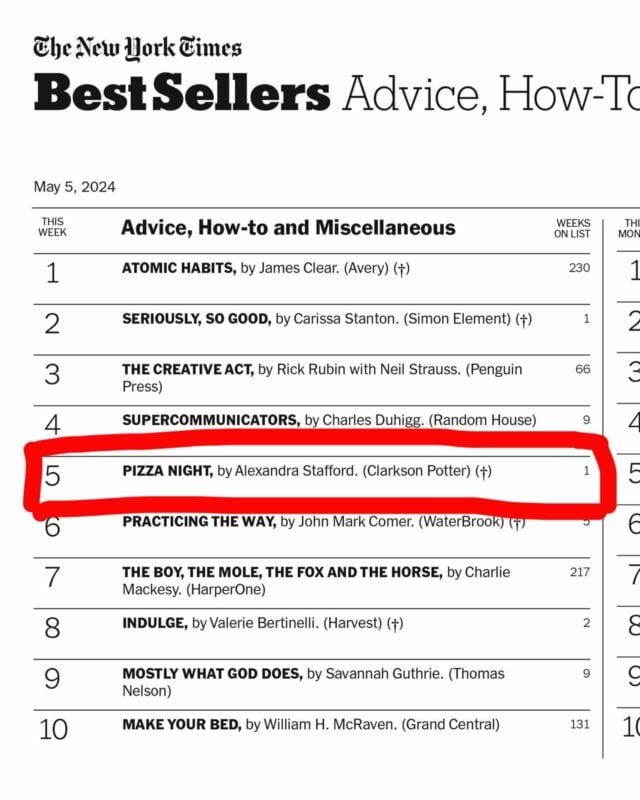



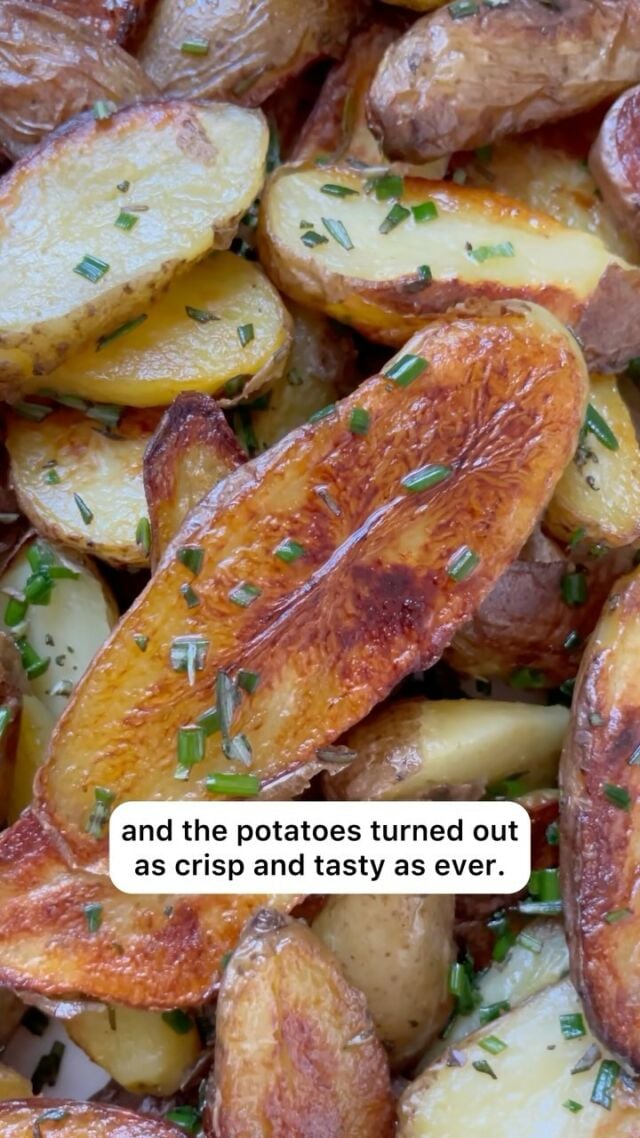

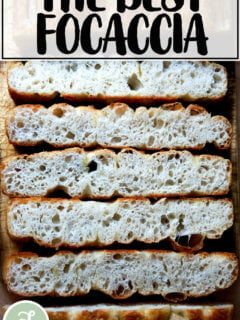
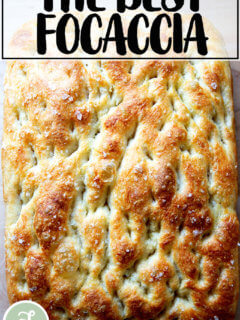
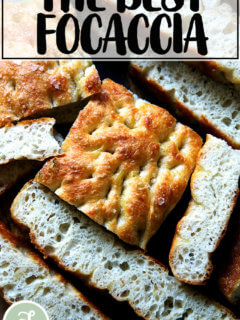
4,163 Comments on “Overnight, Refrigerator Focaccia = The Best Focaccia Bread Recipe”
OMG IM A BREAD BAKER! 😂 This was so easy and so delicious. I sent a picture to my friend, along with the link, and she was like “wow that’s so impressive.” I said girl wait til you read the recipe and see how easy it was! My daughter and I just hovered some with olive oil. Amazing. I cut the rest to use for sandwiches. This will be a staple in our house from now on. I still can’t believe how easy it was!
Great to hear, Meredith! Love reading this all so much 🙂 🙂 🙂
WOW!! Best Focaccaia recipe ever. I am absolutely obsessed and make it at least twice a week now for all my friends and family. They love this recipe too and are in love with the garlic butter addition too. Thank you for sharing
Great to hear, Liv! Thanks so much for writing 🙂 🙂 🙂
I am so happy to have found your site and to receive your bread making emails! Thank you so much for helping me to be able to make homemade bread1. I made the Focaccia today with Rosemary and Garlic and it turned out so good. I did have to cook it longer than your time, but other than that it all went as you instructed. I am guessing to store it I need to do as you state in your Peasant Bread Recipe and put it in a ziplock bag and then reheat it in the oven. Is that correct please? Again thank you so much for making a bread baker out of me!!
So nice to read all of this, Lin! Thanks so much for writing and for your kind words. Yes, that storage method is correct!
Hi, I’m yet to try your recipe, but it looks delicious and I’m doing a food stall at a market and wanted to find out if I can multiply the recipe x 6 for 6 Loaves to rise over 2 days in the fridge in a single bowl and then try split equally into trays for the second rise. Do you know how much the dough weighs when you take it out the fridge when you just do 1 batch? I look forward to hearing from you as soon as possible!
Hi, yes you can. I would only do this if your are using a scale to measure as multiplying by 6 with volume measures will likely be inaccurate. Yes, to 2 days in the fridge. Make sure you have a large enough vessel to store the dough because it will grown considerably in the fridge. Not sure about the weights. You can use this as a guide: total dough weight here is roughly 980 grams and that’s perfect for one 9×13-inch pan.
Hello,
I’m eager to try your Focaccia recipe. Where can I buy a USA Pan like yours?
Thanks
John
Right here: USA Pan. Such a great pan!
This is a really amazing recipe that I’ve used fool proof many times!!!
Just wondering after I’ve taken it out of the fridge, can I leave it for the rise for up to 10 hours?
Great to hear, Maya 🙂 I worry that will be too long. If you need to do a longer proof, I’d return the pan (covered) to the fridge after you ball up the dough and get it in the pan. You’ll still need to let it rest at room temperature before for a few hours before baking.
My son-in-law shared this recipe with me. It’s amazing and the best bread recipe I’ve ever tried! I have since shared it with many friends and family members. The first time I shared it on Christmas Eve, I heard comments like, “This is the best bread I’ve ever eaten!” by people around the table. Thank you so much! I will be on your website from now on looking for other gems.
Great to hear, Beth! Love reading all of this. Thank you for taking the time to write 🙂
I wish I could add the pictures of each time I tried this recipe. AMAZING!!!!
I left one go to 4th day and turned out amazing again.
LOVE THIS RECIPE
Yay! Great to hear, Kassie 🙂 🙂 🙂 Thanks so much for writing.
Oh ive ruined it. I think I’ve put too much oil in it altogether. I can’t get the dimples but I’ve stuck it in the oven anyway. I will have another attempt maybe next week.
I’ve given 5* anyway
Hope it turned out OK Irene! Are you using a scale to measure? I don’t think you could have ruined it with too much oil 🙂
Actually it came out fine but c wighout dimples. I used scales.
I’ll definitely fry again.
Thanks for replying
Hiya! I want to bake this by the morning for breakfast but it is quite late in the evening now- would it be alright to leave it overnight at room temperature? My kitchen is quite cold (around 6⁰C)
Hi! I’m likely too late here. I worry that might be too long — the dough might overferment and it might dry out on the top. I would cover the pan with plastic wrap and stick it in the fridge; then pick up were you left off in the morning.
I have made this recipe more times than I can count and shared it over and over. I love it! There is a recipe floating around for cinnamon roll, focaccia bread. I’m wondering if you might take a stab at that, after your shiny brownie adventure!
Ha! I will get on it 🙂 I have not seen this cinnamon-roll focaccia, but I am intrigued. Great to hear about your focaccia success 🙂 🙂 🙂
This is the second focaccia recipe I’ve tried and it’s the only one I’ll ever need. My first attempt turned out amazing!! I’m so excited, they’re beautiful!
Great to hear! Thanks for writing 🙂
Great recipe!
Great to hear, Ellen!
Can this recipe be easily increased to make multiple?
Yes!
This was my first attempt at making focaccia bread and it was a huge hit! Followed the recipe exactly and it turned out wonderful. I wish I could post a pic for you.
Great to hear, Gwenda! Thanks for writing 🙂
OMG, I usually dont leave comments but i had to for this recipe! This was sooo simple to make, took me less 5 minutes to make the dough. I proofed mine for about 24 hours in the fridge and it was absolutely worth every second of it, i cant wait to make this recipe again with maybe even longer fridge time. Did some olives and cherry tomatoes for the topping. This will definitely become a staple in our home. Thank you so much for this wonderful recipe!
Great to hear Defne! Thanks so much for taking the time to write and share 🙂
Hello! This was delicious- however I made it too dense so it was not fluffy. I’ve made focaccia in the past so I’m not sure what went wrong. Any ideas?? It was still very yummy! Thanks!!!
Hi! Are you using a scale to measure? What type of flour are you using?
This recipe is amazing. I actually used my sourdough discard in this recipe, to avoid food waste, so I didn’t have high hopes but WOW it turned out so so delicious . It’s one I keep coming back to because of how low fuss and low maintenance it is, while still packing a punch on flavour and creating a focaccia with a beautiful texture. I add olives, pickled red onion, and black pepper to mine and it’s heavenly.
That all sounds amazing! Thanks so much for writing and sharing all of this, Aly 🙂
What an amazing discovery this recipe has been! Life-changing (because it’s now become part of my routine and between the kids, my husband and family, it’s requested constantly!). Thanks so much for sharing!
Do you know if this could be frozen at any point in the process? I struggle for fridge space but would like to prepare a few batches.
Great to read all of this, Laura! You can freeze the dough after the first rise.
Omg. Just made this today and I’m loving this sooooooooo much. Thank you!
Great to hear, Kathleen! Thanks for writing 🙂
This is only the 2nd thing I’ve ever baked. I feel like a pro because it came out perfect. We had company over and it was a hit. My confidence at baking (I’m a 57 yo male) is thru the roof thanks to this recipe lol. Thank you for sharing!!
Great to read this, Jim! Thanks so much for writing 🙂
Spent a month messing around with starters and trying different recipes and techniques from other sites with so-so results, then I found your site and game changer! Seriously! After a couple great boules, I decided to give the focaccia a shot (first time ever attempted), but was following your “Simple Sourdough Focaccia Bread” recipe. But after it rose on the counter overnight, I didn’t have time to bake in the morning so put in the refrigerator for 24 hours. I was worried it wouldn’t end well, but then found this recipe and picked up at the part where putting it in the pan for 4-5 hours on the counter (went with your USA recommendation; awesome pan!). Results were incredible!
I made a double batch of dough, but left it in the refrigerator until tomorrow for deep dish pizza. Looking forward to your pizza book! 😉
So nice to read all of this, Eric! It probably was even better after the fridge proof… I feel like magical things happen after any amount of time in the fridge. Thank you for writing. And thank you for your kind words about Pizza Night 🙂
Hello Alexandra,
Looking forward to trying this recipe! I’m inclined to add1-2 TBLS of sourdough discard (or could use fresh/active) to this recipe. Your thoughts?
Go for it!
Good even when you bugger it up a bit! I got my US to Australian measurement conversions wrong and didn’t end up adding enough flour. I knew the dough was too sticky but cooked it anyway. It still came out pretty darn good! Can’t wait to see how good it is when I actually get the recipe right 😅
Great to hear, Annabelle! Thanks so much 🙂
I just made it. Turned out perfect! First time making bread and your directions were so helpful.
Great to hear, Priya! Thanks for writing 🙂 🙂 🙂